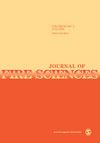Fire risk assessment of cypress wood coated with metal oxide and metal silicate flame retardant using cone calorimeter
IF 1.9
4区 工程技术
Q2 ENGINEERING, MULTIDISCIPLINARY
引用次数: 10
Abstract
This study investigated the fire risk properties of cypress wood for the construction of interiors, especially focusing on heat and smoke hazard properties in fire scenarios. Fire risk characteristics were measured using a cone calorimeter (ISO 5660-1). The external heat flux was maintained at 50 kW/m2. The flame retardants used were metal oxide and metal silicate; they were mixed with a water glass solution. Flame retardants and the silicon compound were dispersed in a concentration of 20 wt% versus 80 wt%, respectively, during 24 h using a magnetic stirrer. The fire performance indexes of the specimens increased by 3–16 times, compared with uncoated specimen and the fire growth index of the specimens increased by 70%–92%. The smoke performance index of the specimens increased by 9–66 times, compared with uncoated specimens. The smoke risk as shown by the smoke performance index increased in the following order: SnO < mica < Co3O4 < ZrSiO4 < cypress. The smoke growth index decreased from 93% to 98%, compared with uncoated wood. The smoke risk due to smoke growth index increased in the following order: SnO < mica < ZrSiO4≈ Co3O4 < cypress. The smoke intensity decreased from a minimum of 85% to a maximum of 99%, compared with uncoated wood. The concentration of CO gas generated after combustion was decreased by 24%–67%. They increased in the following order: mica ≈ ZrSiO4 < SnO < Co3O4 < cypress. A comprehensive assessment of fire performance shows that flame retardants decreased heat hazards, smoke hazards, and CO toxicity.用锥形量热计评估涂有金属氧化物和金属硅酸盐阻燃剂的柏木的火灾风险
本研究调查了用于室内建筑的柏木的火灾危险特性,特别是在火灾情况下的热和烟雾危险特性。使用锥形量热计(ISO 5660-1)测量火灾危险特性。外部热流密度保持在50 kW/m2。使用的阻燃剂有金属氧化物和金属硅酸盐;将它们与水杯溶液混合。用磁力搅拌器将阻燃剂和硅化合物分别以20% wt%和80% wt%的浓度分散24小时。与未涂覆的试样相比,涂覆后试样的防火性能指数提高了3 ~ 16倍,防火生长指数提高了70% ~ 92%。与未涂覆的样品相比,涂覆后样品的防烟性能指标提高了9 ~ 66倍。烟雾性能指标显示的烟雾风险大小顺序为:SnO <云母< Co3O4 < ZrSiO4 <柏树。与未涂覆的木材相比,涂覆后的烟生长指数从93%下降到98%。烟雾生长指数造成的烟雾风险大小顺序为:SnO <云母< ZrSiO4≈Co3O4 <柏树。与未涂覆的木材相比,烟雾强度从最小的85%下降到最大的99%。燃烧后产生的CO气体浓度降低24% ~ 67%。它们的增加顺序为云母≈ZrSiO4 < SnO < Co3O4 <柏木。对防火性能的综合评估表明,阻燃剂降低了热危害、烟雾危害和CO毒性。
本文章由计算机程序翻译,如有差异,请以英文原文为准。
求助全文
约1分钟内获得全文
求助全文
来源期刊

Journal of Fire Sciences
工程技术-材料科学:综合
CiteScore
4.00
自引率
0.00%
发文量
14
审稿时长
2.5 months
期刊介绍:
The Journal of Fire Sciences is a leading journal for the reporting of significant fundamental and applied research that brings understanding of fire chemistry and fire physics to fire safety. Its content is aimed toward the prevention and mitigation of the adverse effects of fires involving combustible materials, as well as development of new tools to better address fire safety needs. The Journal of Fire Sciences covers experimental or theoretical studies of fire initiation and growth, flame retardant chemistry, fire physics relative to material behavior, fire containment, fire threat to people and the environment and fire safety engineering. This journal is a member of the Committee on Publication Ethics (COPE).
 求助内容:
求助内容: 应助结果提醒方式:
应助结果提醒方式:


